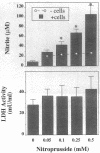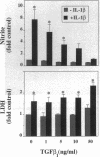Abstract
Nitric oxide (NO) has been implicated as a mediator of physiologic and pathologic cellular injury. Since the cytokine interleukin-1 beta (IL-1 beta) induces nitric oxide synthase (NOS) activity as well as effects morphogenic/cytotoxic changes and increased prostaglandin (PGE2) levels in cultured whole ovarian dispersates, we set out to determine whether these actions are interrelated. Treatment with IL-1 beta resulted in a marked increase in media nitrite and nitrate accumulation, morphological alterations, and increased release of lactate dehydrogenase (LDH) into media. Addition of IL-1 receptor antagonist (RA) eliminated these IL-1 beta effects. In contrast, specific inhibitors of NOS failed to reverse IL-1 beta-induced morphogenic changes or LDH release in spite of complete reduction of media nitrite to control levels. Similarly, treatment with transforming growth factor beta 1, inhibited IL-1 beta-induced nitrite accumulation, but had no effect on the morphologic or cytotoxic endpoints. Moreover, the addition of sodium nitroprusside, an NO generator, resulted in progressive increments in media nitrite content without a corresponding increase in the IL-1 beta-associated morphogenic changes or media LDH content. Furthermore, IL-1-induced PGE2 accumulation remained unaffected by specific NOS inhibition. These observations support the view that NO does not mediate the morphogenic/cytotoxic or inflammatory-like (e.g., PGE2 inducing) properties of IL-1 beta in cultured whole ovarian dispersates. Although the precise role of NO in ovarian physiology remains unknown, it is possible that NO participates in the periovulatory modulation of ovarian blood flow by virtue of its potent vasodilatory activity.
Full text
PDF






Images in this article
Selected References
These references are in PubMed. This may not be the complete list of references from this article.
- Corbett J. A., Sweetland M. A., Wang J. L., Lancaster J. R., Jr, McDaniel M. L. Nitric oxide mediates cytokine-induced inhibition of insulin secretion by human islets of Langerhans. Proc Natl Acad Sci U S A. 1993 Mar 1;90(5):1731–1735. doi: 10.1073/pnas.90.5.1731. [DOI] [PMC free article] [PubMed] [Google Scholar]
- Corbett J. A., Tilton R. G., Chang K., Hasan K. S., Ido Y., Wang J. L., Sweetland M. A., Lancaster J. R., Jr, Williamson J. R., McDaniel M. L. Aminoguanidine, a novel inhibitor of nitric oxide formation, prevents diabetic vascular dysfunction. Diabetes. 1992 Apr;41(4):552–556. doi: 10.2337/diab.41.4.552. [DOI] [PubMed] [Google Scholar]
- Culotta E., Koshland D. E., Jr NO news is good news. Science. 1992 Dec 18;258(5090):1862–1865. doi: 10.1126/science.1361684. [DOI] [PubMed] [Google Scholar]
- Eizirik D. L., Cagliero E., Björklund A., Welsh N. Interleukin-1 beta induces the expression of an isoform of nitric oxide synthase in insulin-producing cells, which is similar to that observed in activated macrophages. FEBS Lett. 1992 Aug 24;308(3):249–252. doi: 10.1016/0014-5793(92)81285-t. [DOI] [PubMed] [Google Scholar]
- Ellman C., Corbett J. A., Misko T. P., McDaniel M., Beckerman K. P. Nitric oxide mediates interleukin-1-induced cellular cytotoxicity in the rat ovary. A potential role for nitric oxide in the ovulatory process. J Clin Invest. 1993 Dec;92(6):3053–3056. doi: 10.1172/JCI116930. [DOI] [PMC free article] [PubMed] [Google Scholar]
- Espey L. L. Ovulation as an inflammatory reaction--a hypothesis. Biol Reprod. 1980 Feb;22(1):73–106. doi: 10.1095/biolreprod22.1.73. [DOI] [PubMed] [Google Scholar]
- Geller D. A., Lowenstein C. J., Shapiro R. A., Nussler A. K., Di Silvio M., Wang S. C., Nakayama D. K., Simmons R. L., Snyder S. H., Billiar T. R. Molecular cloning and expression of inducible nitric oxide synthase from human hepatocytes. Proc Natl Acad Sci U S A. 1993 Apr 15;90(8):3491–3495. doi: 10.1073/pnas.90.8.3491. [DOI] [PMC free article] [PubMed] [Google Scholar]
- Geller D. A., Nussler A. K., Di Silvio M., Lowenstein C. J., Shapiro R. A., Wang S. C., Simmons R. L., Billiar T. R. Cytokines, endotoxin, and glucocorticoids regulate the expression of inducible nitric oxide synthase in hepatocytes. Proc Natl Acad Sci U S A. 1993 Jan 15;90(2):522–526. doi: 10.1073/pnas.90.2.522. [DOI] [PMC free article] [PubMed] [Google Scholar]
- Green L. C., Wagner D. A., Glogowski J., Skipper P. L., Wishnok J. S., Tannenbaum S. R. Analysis of nitrate, nitrite, and [15N]nitrate in biological fluids. Anal Biochem. 1982 Oct;126(1):131–138. doi: 10.1016/0003-2697(82)90118-x. [DOI] [PubMed] [Google Scholar]
- Gross S. S., Stuehr D. J., Aisaka K., Jaffe E. A., Levi R., Griffith O. W. Macrophage and endothelial cell nitric oxide synthesis: cell-type selective inhibition by NG-aminoarginine, NG-nitroarginine and NG-methylarginine. Biochem Biophys Res Commun. 1990 Jul 16;170(1):96–103. doi: 10.1016/0006-291x(90)91245-n. [DOI] [PubMed] [Google Scholar]
- Hibbs J. B., Jr, Taintor R. R., Vavrin Z., Rachlin E. M. Nitric oxide: a cytotoxic activated macrophage effector molecule. Biochem Biophys Res Commun. 1988 Nov 30;157(1):87–94. doi: 10.1016/s0006-291x(88)80015-9. [DOI] [PubMed] [Google Scholar]
- Hibbs J. B., Jr, Vavrin Z., Taintor R. R. L-arginine is required for expression of the activated macrophage effector mechanism causing selective metabolic inhibition in target cells. J Immunol. 1987 Jan 15;138(2):550–565. [PubMed] [Google Scholar]
- Hurwitz A., Hernandez E. R., Payne D. W., Dharmarajan A. M., Adashi E. Y. Interleukin-1 is both morphogenic and cytotoxic to cultured rat ovarian cells: obligatory role for heterologous, contact-independent cell-cell interaction. Endocrinology. 1992 Oct;131(4):1643–1649. doi: 10.1210/endo.131.4.1396309. [DOI] [PubMed] [Google Scholar]
- Hurwitz A., Payne D. W., Packman J. N., Andreani C. L., Resnick C. E., Hernandez E. R., Adashi E. Y. Cytokine-mediated regulation of ovarian function: interleukin-1 inhibits gonadotropin-induced androgen biosynthesis. Endocrinology. 1991 Sep;129(3):1250–1256. doi: 10.1210/endo-129-3-1250. [DOI] [PubMed] [Google Scholar]
- Hurwitz A., Ricciarelli E., Botero L., Rohan R. M., Hernandez E. R., Adashi E. Y. Endocrine- and autocrine-mediated regulation of rat ovarian (theca-interstitial) interleukin-1 beta gene expression: gonadotropin-dependent preovulatory acquisition. Endocrinology. 1991 Dec;129(6):3427–3429. doi: 10.1210/endo-129-6-3427. [DOI] [PubMed] [Google Scholar]
- Jaffe B. M., Behrman H. R., Parker C. W. Radioimmunoassay measurement of prostaglandins E, A, and F in human plasma. J Clin Invest. 1973 Feb;52(2):398–405. doi: 10.1172/JCI107196. [DOI] [PMC free article] [PubMed] [Google Scholar]
- Kilbourn R. G., Gross S. S., Lodato R. F., Adams J., Levi R., Miller L. L., Lachman L. B., Griffith O. W. Inhibition of interleukin-1-alpha-induced nitric oxide synthase in vascular smooth muscle and full reversal of interleukin-1-alpha-induced hypotension by N omega-amino-L-arginine. J Natl Cancer Inst. 1992 Jul 1;84(13):1008–1016. doi: 10.1093/jnci/84.13.1008. [DOI] [PubMed] [Google Scholar]
- Kokia E., Hurwitz A., Ricciarelli E., Tedeschi C., Resnick C. E., Mitchell M. D., Adashi E. Y. Interleukin-1 stimulates ovarian prostaglandin biosynthesis: evidence for heterologous contact-independent cell-cell interaction. Endocrinology. 1992 May;130(5):3095–3097. doi: 10.1210/endo.130.5.1572315. [DOI] [PubMed] [Google Scholar]
- Langrehr J. M., Hoffman R. A., Lancaster J. R., Jr, Simmons R. L. Nitric oxide--a new endogenous immunomodulator. Transplantation. 1993 Jun;55(6):1205–1212. doi: 10.1097/00007890-199306000-00001. [DOI] [PubMed] [Google Scholar]
- Lowenstein C. J., Snyder S. H. Nitric oxide, a novel biologic messenger. Cell. 1992 Sep 4;70(5):705–707. doi: 10.1016/0092-8674(92)90301-r. [DOI] [PubMed] [Google Scholar]
- Malinowska D. H. Permeabilizing parietal cells. Methods Enzymol. 1990;192:108–124. doi: 10.1016/0076-6879(90)92065-l. [DOI] [PubMed] [Google Scholar]
- Moncada S., Palmer R. M., Higgs E. A. Nitric oxide: physiology, pathophysiology, and pharmacology. Pharmacol Rev. 1991 Jun;43(2):109–142. [PubMed] [Google Scholar]
- Nguyen T., Brunson D., Crespi C. L., Penman B. W., Wishnok J. S., Tannenbaum S. R. DNA damage and mutation in human cells exposed to nitric oxide in vitro. Proc Natl Acad Sci U S A. 1992 Apr 1;89(7):3030–3034. doi: 10.1073/pnas.89.7.3030. [DOI] [PMC free article] [PubMed] [Google Scholar]
- Palmer R. M., Hickery M. S., Charles I. G., Moncada S., Bayliss M. T. Induction of nitric oxide synthase in human chondrocytes. Biochem Biophys Res Commun. 1993 May 28;193(1):398–405. doi: 10.1006/bbrc.1993.1637. [DOI] [PubMed] [Google Scholar]
- Roberts A. B., Vodovotz Y., Roche N. S., Sporn M. B., Nathan C. F. Role of nitric oxide in antagonistic effects of transforming growth factor-beta and interleukin-1 beta on the beating rate of cultured cardiac myocytes. Mol Endocrinol. 1992 Nov;6(11):1921–1930. doi: 10.1210/mend.6.11.1282674. [DOI] [PubMed] [Google Scholar]
- Sarih M., Souvannavong V., Adam A. Nitric oxide synthase induces macrophage death by apoptosis. Biochem Biophys Res Commun. 1993 Mar 15;191(2):503–508. doi: 10.1006/bbrc.1993.1246. [DOI] [PubMed] [Google Scholar]
- Southern C., Matthews N. Nitric oxide is produced during TNF killing of U937A cells but does not contribute to the cytotoxic process. Biochim Biophys Acta. 1993 Jun 6;1177(2):179–182. doi: 10.1016/0167-4889(93)90038-q. [DOI] [PubMed] [Google Scholar]
- Stamler J. S., Singel D. J., Loscalzo J. Biochemistry of nitric oxide and its redox-activated forms. Science. 1992 Dec 18;258(5090):1898–1902. doi: 10.1126/science.1281928. [DOI] [PubMed] [Google Scholar]
- Stuehr D. J., Nathan C. F. Nitric oxide. A macrophage product responsible for cytostasis and respiratory inhibition in tumor target cells. J Exp Med. 1989 May 1;169(5):1543–1555. doi: 10.1084/jem.169.5.1543. [DOI] [PMC free article] [PubMed] [Google Scholar]









